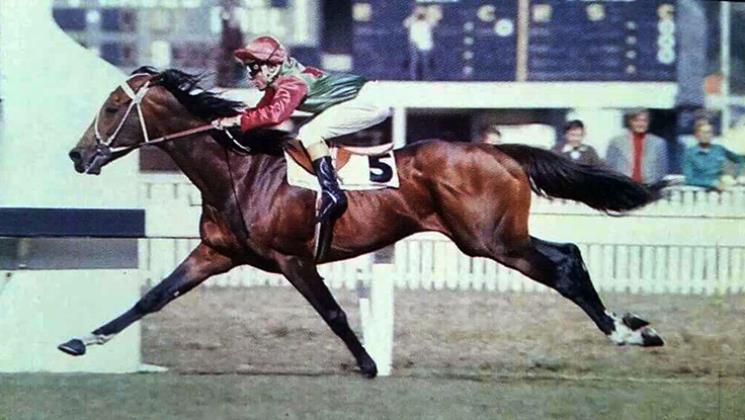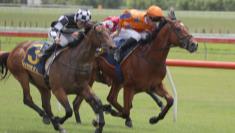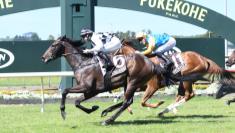
Kiwis Well Represented in Australian HOF Induction
Balmerino shows off his impressive stride during his winning run in the 70s.
Champion New Zealand galloper Balmerino, who took on the best in six countries in the 1970s, will be in select company when he is inducted into the Australian Racing Hall of Fame this weekend.
It is rare for a New Zealand-trained galloper to gain entry into the Australian Hall of Fame and Balmerino joins Let’s Elope – who was sold to Australia as a three-year-old – and Sunline as the only Australian Hall of Famers who have raced in New Zealand in the last 50 years.
Ten inductees will be added to the Australian Hall of Fame in Friday, at a ceremony in Brisbane, with the group including three Kiwis who made their mark in both hemispheres.
Balmerino will be joined by top jockey Brent Thomson, who won the Cox Plate four times before he turned 22, and the New Zealand-bred star So You Think.
All three are already in the New Zealand Racing Hall of Fame.
Balmerino, who was foaled in 1972, was an outstanding three and four-year-old in New Zealand and Australia, before taking on the best in the Northern Hemisphere.
He was raced by his breeder, Ralph Stuart, and trained at Cambridge by a youthful Brian Smith, who is still training successfully in Brisbane.
Balmerino had a lengthy but near faultless three-year-old campaign, with 14 wins and three seconds from 18 races. He won nine races in New Zealand and another five in Australia.
He raced at least once in every month from August through to June, beginning with a second over 1200m and ending his campaign by beating the older horses in the 3200m Brisbane Cup.
He faced a good crop of New Zealand three-year-olds, including March Legend, Caboodle, Happy Union and Nuriootpa but dominated his rivals, winning the New Zealand Derby, Two Thousand Guineas, Wellington Derby, Avondale Guineas and Hawke’s Bay Guineas.
He beat the older horses in the Rawson (Ranvet) Stakes in Sydney at his Australian debut before defeating the top Australian three-year-old Lord Dudley in the Tulloch Stakes.
He also ran second in the Queen Elizabeth Stakes at Randwick, before heading to Brisbane, where he was unbeaten in three starts, winning the Grand Prix Stakes and O’Shea Stakes before his Brisbane Cup triumph.
It was during Balmerino’s three-year-old campaign that Stuart and Smith began to dream about a tilt at the Arc de Triomphe in France.
A back injury hampered Balmerino’s spring campaign as a four-year-old but he still ran second in the Feehan Stakes and Turnbull Stakes in Melbourne.
Freshened after three spring runs, he was just beaten in the Waikato Sprint at Te Rapa before winning the New Zealand Stakes and Awapuni Gold Cup and the Autumn Stakes in Sydney.
He had his last New Zealand start when winning the Ormond Memorial at Hastings and five weeks later was racing in California, in the Hollywood Invitational.
It was the start of an international campaign that took in him to the United States (twice), England, France and Italy.
Brian Smith prepared Balmerino for his Californian campaign, which produced one win from four attempts, before the horse was transferred to leading English trainer John Dunlop.
The high point of Balmerino’s northern hemisphere career was his outstanding run for second, behind the three-year-old Alleged, in the 1977 Arc de Triomphe, a race that was broadcast live on radio in New Zealand, with Peter Kelly providing the call.
Balmerino came from well back in the 26-horse field but could not catch Alleged, who had set the pace for Lester Piggott. Alleged was beaten only once in his career and returned to win the Arc again the following year.
Balmerino was first past the post in a Group I race in Italy at his next start but was relegated to second.
He struggled to maintain his best form in England, as an older - and much-travelled - entire, but still won two weight-for-age races at Goodwood and was runner-up at Group I level in both the Coronation Cup and Eclipse Stakes and earned a Timeform rating of 133 in 1977.
He retired from racing with a career record of 22 wins and 11 seconds from 46 starts.
He returned to New Zealand for his stud career, at Middlepark Stud at Cambridge, and sired seven Group I winners, the best being Bounty Hawk, who won five Group I races.
So You Think, a son of High Chaparral, was bred in partnership by Mike Moran and Piper Farm, and was a $110,000 yearling buy for Bart Cummings at Karaka.
So You Think was good enough to win the Cox Plate as a three-year-old, at just his fifth start, and as a four-year-old dominated the Melbourne spring carnival. He won the Group II Memsie Stakes first up and then recorded four successive Group I wins, including the Cox Plate and Mackinnon Stakes.
He had his final Australian start when a brave third, under 56kg, on a slow track in the Melbourne Cup. Coolmore Stud then bought a majority share in the horse and he was transferred to Irish trainer Aidan O’Brien.
So You Think added five more Group I wins in the Northern Hemisphere and took on the best in a schedule that included races in England, Ireland, France, the United States and Dubai.
He won six races for O’Brien and ended his career on a high when winning the Group I Prince of Wales’s Stakes at the 2012 Royal Ascot meeting. In addition to his Group I triumphs, So You Think ran fourth in the Arc de Triomphe and the Dubai World Cup.
He had only 23 starts in his career, winning 14.
He has already made an impression as a sire, particularly in Australia and New Zealand, where he has been represented by five Group I winners.









